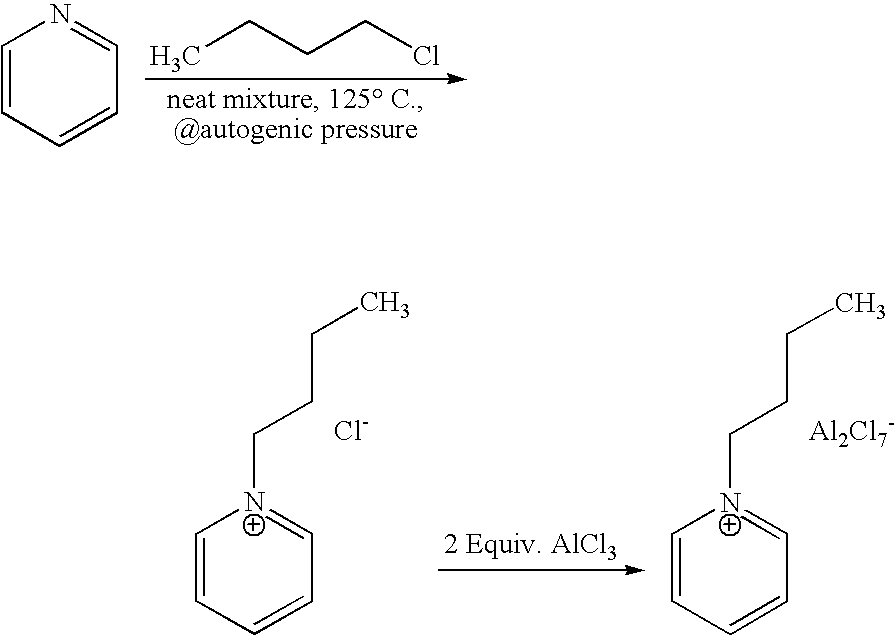Process for the formation of a superior lubricant or fuel blendstock by ionic liquid oligomerization of olefins in the presence of isoparaffins
- Summary
- Abstract
- Description
- Claims
- Application Information
AI Technical Summary
Benefits of technology
Problems solved by technology
Method used
Image
Examples
example 1
Preparation of Fresh 1-Butyl-pyridinium Chloroaluminate Ionic Liquid
[0037] 1-butyl-pyridinium chloroaluminate is a room temperature ionic liquid prepared by mixing neat 1-butyl-pyridinium chloride (a solid) with neat solid aluminum trichloride in an inert atmosphere. The syntheses of 1-butyl-pyridinium chloride and the corresponding 1-butyl-pyridinium chloroaluminate are described below. In a 2-L Teflon-lined autoclave, 400 gm (5.05 mol.) anhydrous pyridine (99.9% pure purchased from Aldrich) were mixed with 650 gm (7 mol.) 1-chlorobutane (99.5% pure purchased from Aldrich). The neat mixture was sealed and let to stir at 125° C. under autogenic pressure over night. After cooling off the autoclave and venting it, the reaction mix was diluted and dissolved in chloroform and transferred to a three liter round bottom flask. Concentration of the reaction mixture at reduced pressure on a rotary evaporator (in a hot water bath) to remove excess chloride, un-reacted pyridine and the chloro...
example 2
Oligomerization of 1-Decene in Ionic Liquids in the Present of iso-Butane
[0039] Oligomerization of 1-decene was carried out in acidic 1-butyl-pyridinium chloroaluminate in the presence of 10 mole % of isobutane. The reaction was done in the presence of HCl as a promoter. The procedure below describes, in general, the process. To 42 gm of 1-butyl-pyridinium chloroaluminate in a 300 cc autoclave fitted to an overhead stirrer, 101 gm of 1-decene and 4.6 gm of isobutane were added and the autoclave was sealed. Then 0.4 gm of HCl was introduced and the stirring started. The reaction was heated to 50° C. The reaction was exothermic and the temperature quickly jumped to 88° C. The temperature in few minutes went back down to 44° C. and was brought up to 50° C. and the reaction was vigorously stirred at about 1200 rpm for an hour at the autogenic pressure (˜atmospheric pressure in this case). Then, the stirring was stopped and the reaction was cooled to room temperature. The contents were ...
example 3
Oligomerization of a Mixture of Alpha Olefins in the Presence of iso-Butane
[0042] A 1:1:1 mixture of 1-hexene:1-octene:1-decene was oligomerised in the presence of isobutane at the reaction conditions described earlier for oligomerization of 1-decene in the presence of isobutane (100 gm olefins, 20 gm IL catalyst, 0.25 gm HCl as co-catalyst, 50° C., autogenic pressure, 1 hr). The products were separated from the IL catalyst, and the IL layer was rinsed with hexane, which was decanted off and added to the products. The products and the hexane wash were treated with 0.1N NaOH to remove any residual AlCl3. The organic layers were collected and dried over anhydrous MgSO4. Concentration (on a rotary evaporator at reduced pressure, in a water bath at ˜70 degrees C.) gave the oligomeric product as viscous yellow oils. Table 2 below shows the Simulated Distillation, viscosity, and pour point and cloud point data of the alkylated oligomeric products of the olefinic mixture in the presence o...
PUM
| Property | Measurement | Unit |
|---|---|---|
| Temperature | aaaaa | aaaaa |
| Fraction | aaaaa | aaaaa |
| Time | aaaaa | aaaaa |
Abstract
Description
Claims
Application Information
 Login to View More
Login to View More - R&D
- Intellectual Property
- Life Sciences
- Materials
- Tech Scout
- Unparalleled Data Quality
- Higher Quality Content
- 60% Fewer Hallucinations
Browse by: Latest US Patents, China's latest patents, Technical Efficacy Thesaurus, Application Domain, Technology Topic, Popular Technical Reports.
© 2025 PatSnap. All rights reserved.Legal|Privacy policy|Modern Slavery Act Transparency Statement|Sitemap|About US| Contact US: help@patsnap.com

